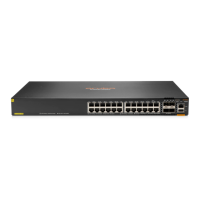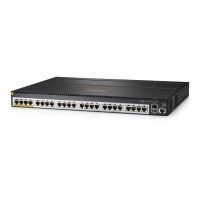130
Diagnosing transceiver modules
The device provides the alarm and digital diagnosis functions for transceiver modules. When a
transceiver module fails or is not operating correctly, you can perform the following tasks:
• Check the alarms that exist on the transceiver module to identify the fault source.
• Examine the key parameters monitored by the digital diagnosis function, including the
temperature, voltage, laser bias current, TX power, and RX power.
To diagnose transceiver modules, execute the following commands in any view:
Task Command Remarks
Display transceiver alarms.
display transceiver alarm
{
interface
[ interface-type
interface-number ] }
N/A
Display the current values of the
digital diagnosis parameters on
transceiver modules.
display transceiver diagnosis
{
interface
[ interface-type
interface-number ] }
This command cannot display
information about some
transceiver modules.
Disabling transceiver module source alarm
NOTE:
This feature is available in Release 3113P05 and later.
The device regularly checks transceiver modules for their vendor names. If a transceiver module
does not have a vendor name or the vendor name is not HPE, the device repeatedly outputs traps
and log messages. Disable transceiver module source alarm if the transceiver modules were
manufactured or sold by Hewlett Packard Enterprise.
To disable transceiver module source alarm:
Step Command Remarks
1. Enter system view.
system-view
N/A
2. Disable transceiver module
source alarm.
transceiver
phony-alarm-disable
By default, transceiver module
source alarm is enabled.
Restoring the factory-default settings and states
CAUTION:
This feature is disruptive. Use this feature only when you cannot troubleshoot the device by using
other methods, or you want to use the device in a different scenario.
This feature does the following:
• Deletes all configuration files (.cfg files) in the root directories of the storage media.
• Deletes all log files (.log files in the folder /logfile).
• Clears all log information (in the log buffer), trap information, and debugging information.
• Restores the parameters for the Boot ROM options to the factory-default settings.

